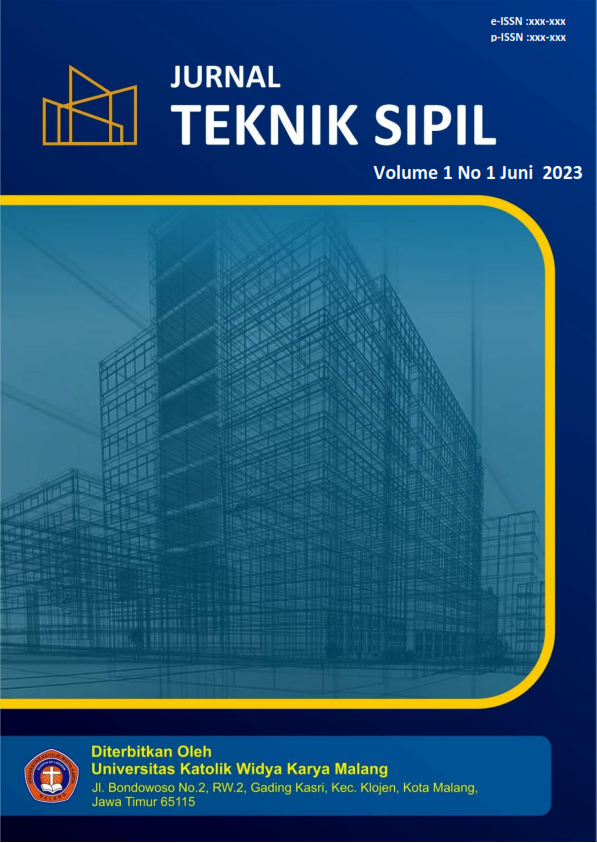Pemodelan Nilai Koefisien Debit Pada Pintu Air
Keywords:
Discharge coefficient, contraction coefficient, second order polynomialAbstract
The sluice gate in a dam has a very important function to hold large amounts of discharge. The sluice gate can also act as a regulator of water flow for irrigation so that water can flow to the waterways according to the desired debit. With a large discharge and pressing the sluice gate so that when opening the sluice gate it must be in accordance with the rules. The flow of water that passes through the sluice with a large discharge will immediately flow with a super critical flow, so that it can erode the bottom of the canal. The heavy flow of water can be inhibited or reduced by adding baffle blocks thereby reducing the speed of the water flow. This research seeks and models the value of the discharge coefficient at the floodgates. Different sluice openings can affect a hydraulic jump so that the discharge coefficient (Cd) and contraction coefficient (Cc) arise and how to get the results from the discharge and contraction coefficients is very difficult because of the changing waves. This research was conducted at the Laboratory of River Engineering – Irrigation Engineering, University of Brawijaya using quantitative methods with the help of Microsoft Excel for the calculations. By having some secondary data and calculating the relationship between the discharge coefficient and the sluice gate and a second-order polynomial with an average discharge coefficient of around (0.464 – 1.633) and a contraction coefficient of around (0.675 – 2.977) using a rectangular baffle block and using sills of the same size different
References
Abdurrosyid, J., & Pratiwi, P. (2020). K AJIAN P ENGARUH S LOTTED DAN B AFFLE B LOCKS PADA K OLAM O LAK S TUDY OF S LOTTED AND B AFFLE B LOCK I MPACT ON E NERGY D ISSIPATION IN R OLLER. 3(1), 1–9.
Ain, S. (2016). KAJIAN LONCATAN HIDROLIK (HYDRAULIC JUMP) PADA BUKAAN PINTU AIR SALURAN IRIGASI BERBENTUK SEGI EMPAT SKALA LABORATORIUM. 14–16.
Arifin. (2012). PENGARUH ENERGI ALIRAN TERHADAP KOLAM OLAKAN AKIBAT LONCATAN HIDROLIK (UJI MODEL LABORATORIUM.
Astuti, S. I., Arso, S. P., & Wigati, P. A. (2015). PINTU AIR,FUNGSI KATUP/PINTU. Analisis Standar Pelayanan Minimal Pada Instalasi Rawat Jalan Di RSUD Kota Semarang, 3, 103–111.
BPSDM. (n.d.). 0d3db_Pelimpah.
Davis, H. E. (1988). OPEN CHANEL HYDRAULICS.
García Reyes, L. E. (2013). Jenis Pintu Air dan Katup. Journal of Chemical Information and Modeling, 53(9), 1689–1699.
Hidayah, S., & Prihantoko, A. (2017). Pintu Air Irigasi Elektromekanis Kombinasi Aliran Atas dan Bawah. Jurnal Irigasi, 11(2), 113. https://doi.org/10.31028/ji.v11.i2.113-124
Nurjanah, R. A. D. (2014). ANALISIS TINGGI DAN PANJANG LONCAT AIR PADA BANGUNAN UKUR BERBENTUK SETENGAH LINGKARAN. Jurnal Teknik Sipil Dan Lingkungan, 2(3), 578–582.
Price, N. E. W. (2020). Bagian Pintu Air. 2–4.
Pusat Pendidikan dan Pelatihan Sumber Daya Air dan Konstruksi. (2016). Perencanaan Bangunan Utama (Bendung) Diklat Teknis Perencanaan Irigasi Tingkat Dasar. Modul Pengenalan Sistem Irigasi, Perencanaan Bendungan.
Rizaldy, A., Musa, R., & Mallombasi, A. (2021). Kalibrasi Koefisien Debit Model Bukaan Pintu Sorong Pada Saluran Terbuka (Uji Laboratorium). Jurnal Teknik Sipil MACCA, 6(1), 1–10.
Saluran, H. (1985). Jenis Aliran Air. 32–54.
Shayan, H. K., & Farhoudi, J. (2013). Theoretical Criterion for Stability of Free Hydraulic Jump on Adverse Stilling Basins. 1, 53–66.
Sunik, S. (2019). Characteristic of Contraction. Jurnal Teknik Sipil, 15(3), 170–175.
Sunik, S. (2020). Contraction coefficient (Cc) characteristic for flow under sluice gate using trapezoid baffle block and sill. Water and Energy International, 63r(3), 37–41.















